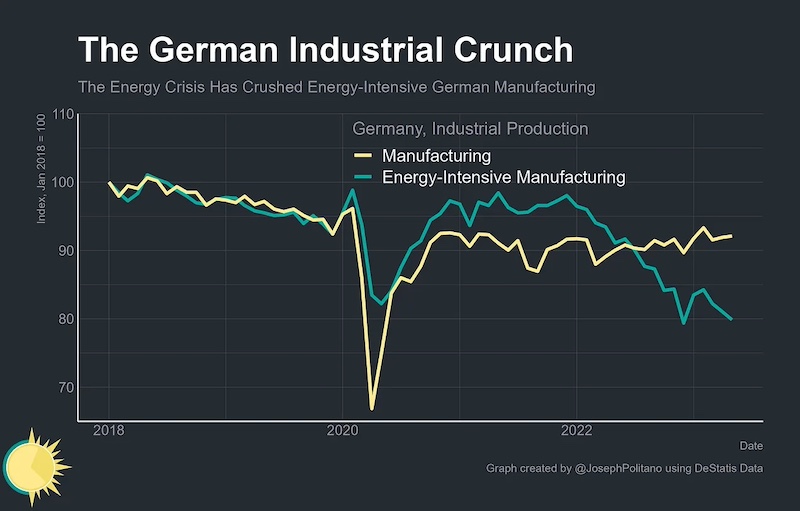Germany, often hailed as Europe’s economic powerhouse, is grappling with a significant downturn in its manufacturing sector. Once the cornerstone of its robust economy, manufacturing is now facing serious challenges that threaten the stability of the wider economy.
Germany is of particular interest to this website for obvious reasons. Apart from Japan, Germany has shown itself – or at least the manufacturing sector has shown itself – to be the most highly proficient at using robotics and automation technologies. That’s our opinion anyway.
And while China may have overloaded the world with manufactured products in every category you can imagine, German products still inspire confidence in people who appreciate precision, quality and originality.
In this article, we look into the origins of Germany’s current woes, their broader implications, and potential pathways to recovery.
It’s the economy, stupid
The German manufacturing sector, a key pillar of the nation’s economy, has been in decline for several years, but the situation has worsened recently.
The industrial production index, which measures output across key manufacturing sectors, has fallen by over 5 percent since 2018. In 2023, manufacturing contributed just under 20 percent of Germany’s $4.5 trillion GDP, which is a considerable decrease from the 23 percent it contributed a decade ago.
Exports, which are crucial for Germany’s economy, have also seen a slump. Data from the German Federal Statistical Office shows that export growth slowed to a mere 1.2 percent in 2023, compared to 4.8 percent in 2017. But at least it’s still growing.
Predictions for 2024 indicate further contraction, with institutions like the Ifo Institute forecasting industrial production to fall by another 2 percent amid declining global demand.
It’s your own volk
Now let’s look into the causes of the current downturn in Germany’s fortunes. A quick summary might be that most of the factors are external, so Germany is powerless to do anything about its own predicament – which is probably more worrying than anything else.
Energy supply issues and the Russia-Ukraine War
The Russia-Ukraine war has had a profound impact on Germany’s energy supply, given its historical dependence on Russian natural gas. The sudden disruption in energy imports led to a spike in prices, forcing industries to curtail production. Energy-intensive sectors like chemicals, steel, and automotive manufacturing have been particularly affected, with some plants shutting down entirely.
Global economic headwinds
The global economy has faced turbulence due to factors like inflation, supply chain disruptions, and a slowdown in China—Germany’s largest trading partner. Reduced demand from China for machinery and automobiles has hit German exports hard.
Political and economic interplay
Germany’s political landscape is also strained. Internal disagreements within the governing coalition and debates over energy transition policies have exacerbated the economic uncertainty. It is debatable whether the political crisis is a cause or consequence of the economic problems, but the two are undeniably intertwined.
Structural challenges
Germany’s manufacturing sector is also struggling with structural issues, including a lack of skilled labour, aging infrastructure, and slow adoption of digital technologies compared to competitors like South Korea and Japan. These factors have hindered innovation and efficiency.
Broader economic implications
The manufacturing downturn is reverberating throughout Germany’s economy. Manufacturing’s decline has led to job losses, particularly in industrial hubs like Bavaria and Baden-Württemberg. Unemployment in manufacturing-dependent regions has risen by 1.5% since 2022, creating social and economic stress.
Moreover, Germany’s trade surplus, a source of national pride and economic stability, has shrunk. The knock-on effects extend to logistics, supply chains, and even the global robotics industry, which relies on German precision machinery.
Can Germany turn the tide?
Germany faces a daunting task in revitalising its manufacturing sector. While the challenges are significant, there are pathways to recovery:
Energy security
Accelerating the transition to renewable energy sources, such as wind and solar, can reduce dependency on foreign energy imports. Investment in hydrogen technology, where Germany is already a leader, could also provide a competitive edge.
Digital transformation
Embracing Industry 4.0 technologies, including robotics, artificial intelligence, and IoT, can boost productivity and efficiency. The German government’s “Digital Strategy 2025” aims to support such initiatives, but its implementation needs to be expedited.
Diversification of export markets
Expanding trade relationships beyond traditional markets like China and the US can mitigate risks. Emerging markets in Africa and Southeast Asia offer untapped potential.
Skill development
Addressing the labour shortage by investing in vocational training and attracting skilled immigrants can ensure a steady pipeline of talent for the manufacturing sector.
Kraft werk
Germany’s manufacturing sector has faced downturns before, most notably during the Great Depression and the global financial crisis of 2008. In both cases, recovery was driven by innovation and adaptability. For example, post-2008, Germany’s adoption of automation and robotics helped it regain its competitive edge.
Looking ahead, emerging technologies could play a pivotal role in stabilising and revitalising the sector. Germany is well-positioned to lead in electric vehicle production, with companies like Volkswagen making significant investments. Additionally, advancements in robotics and automation, fields where Germany excels, could offset labour shortages and improve efficiency.
Autonomous articulated vehicles are the way to go
Germany’s manufacturing woes are a significant concern, not just for the nation but for the global economy. However, Germany has a history of resilience and innovation. By addressing structural challenges and leveraging technological advancements, it can navigate this turbulent period and maintain its position as a global manufacturing leader.
While the road to recovery will be long and complex, Germany’s industrial heritage and engineering prowess provide a strong foundation for overcoming these challenges. The world will be watching as Germany strives to reclaim its economic vitality.
And for the country which articulated the concept of Industry 4.0, the comeback shouldn’t take very long.
Graph courtesy of Apricitas.io




